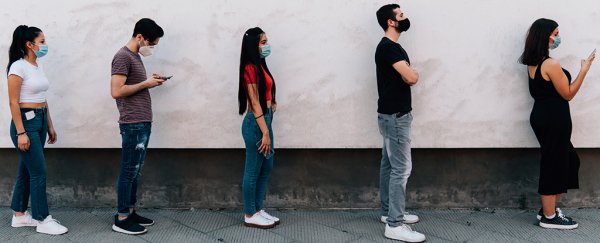From what we know about SARS-CoV-2, somewhere between 60 and 72 percent of a population needs to be immune to the virus for its spread to stop. That's without taking isolation measures into account.
The exact number will depend on how well the vaccine actually works. Trials on promising candidate vaccines by Pfizer and Moderna have determined an effectiveness of 90 and 94 percent respectively, with immunity taking two weeks to develop following recommended doses.
Even with an incomplete course, trial data suggests the Pfizer vaccine will most likely provide some degree of immunity.
Based on those estimates, at least 7 out of 10 people would need to be fully vaccinated with the recommended two doses to be confident of widespread immunity.
Some experts estimate that immunising just two-thirds of a population could be enough to halt the pandemic disease and help protect whole communities or nations.
But there are a number of assumptions hiding behind this estimate, risking high expectations.
For example, if immunity is found to be brief, on the scale of months to even a year or so, coordinating a period where around three quarters of all people are immune could be made more difficult.
Then there is the question of whether clinical trials accurately represent the potential level of immunity we can achieve in a more diverse population.
It also depends on how many people already have a degree of immunity through a previous infection. Given we are likely to be underestimating infection rates worldwide, this number is probably higher than current statistics indicate.
Will a vaccine end the COVID-19 pandemic?
A vaccine will almost certainly play a key role in any scenario where the COVID-19 pandemic ends.
This success depends on a number of factors, many of which are still unknown.
Based on statistics describing the growing trends of infections, and potential for underreporting, we might expect somewhere between 80 million to as many as half a billion people around the globe might have experienced - and many recovered from - a SARS-CoV-2 infection by the start of 2021.
This implies somewhere between 1 and 6 percent of the world's 7.8 billion people could already have a degree of immunity - far short of the roughly 60 to 70 percent herd immunity some studies estimate we might need.
Of course, the precise number of those who are now immune varies considerably from one nation to the next. In the US, the figure could rise above 10 percent by the end of the year as infection rates continue to climb. In Australia and New Zealand, it's considerably less than just one percent.
Taking the US as an example, assuming an existing immunity of 20 million people by the time the first vaccines are implemented in January 2021, a further 210 million people would need to be vaccinated for there to be a high chance of SARS-CoV-2 being eradicated, according to some estimates.
At 90 percent effectiveness, the Pfizer vaccine on its own would need to reach roughly 235 million people at the very least, all within the same time window of immunity. That's assuming if one in 10 US citizens is already immune.
Since we don't know how long immunity lasts, the precise length of this period is yet another unknown.
Whether we should even make full eradication a goal is also up for debate, with some maintaining a more realistic focus should be on continuing to determine who is vulnerable and preserving their health.
How likely is it that 235 million Americans will be fully vaccinated within a year or so of vaccines being rolled out?
Vaccine uptake depends on a range of factors, from access to healthcare to distribution to personal beliefs and values on vaccinations.
Influenza vaccination uptake was just under 64 percent among minors for the 2019-20 flu season, and just over 48 percent among adults. Both were slightly up from previous seasons, but well short of the necessary numbers that would be required to eradicate SARS-CoV-2.
Having personal experience of an infection through a friend's or loved one's suffering does appear to make a difference in uptake for other types of vaccines. It's possible a sufficient media campaign for a COVID-19 vaccine, along with easy access to mobile vaccinations clinics, could nudge vaccination uptake in most accessible places around the globe past 70 percent by December 2021.
Though with targeted campaigns being waged by anti-vaccination groups through social media, it's hard to say which way vaccination rates might go.
In July 2020, the US reserved 100 million doses of the Pfizer vaccine as part of a US$1.95 billion deal, which will provide an initial 50 million vulnerable citizens and essential workers with a chance of immunity. With other nations bidding for vaccines and production speed limited, it's hard to say how soon additional doses will be rolled out.
The best chance of success at eradicating SARS-CoV-2 will more than likely entail a mix of vaccination, social distancing, and the continued wearing of masks in public spaces for the foreseeable future.
All Explainers are determined by fact checkers to be correct and relevant at the time of publishing. Text and images may be altered, removed, or added to as an editorial decision to keep information current.
